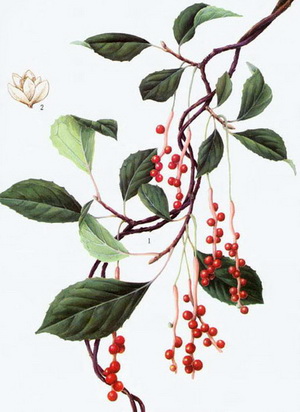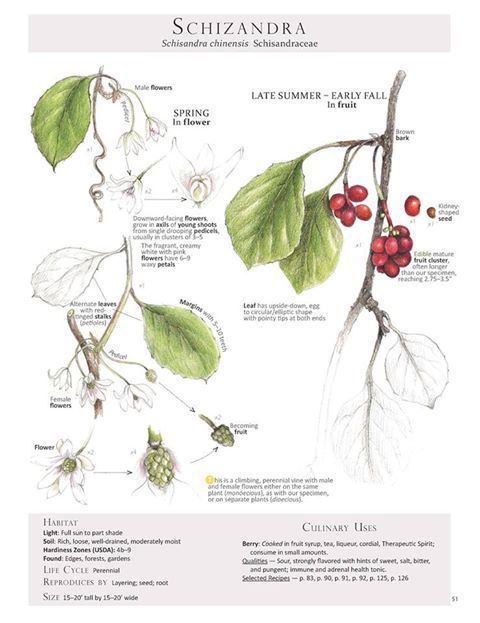SCHIZANDRA BERRIES WERE WIDELY USED BY THE ANCIENT CHINESE ROYALTY AS A BEAUTIFIER, YOUTH PRESERVER, AND REPRODUCTIVE TONIC.
It is still very popular in the Asian culture today often used to help improve mental function, to strengthen sex organs, and as a skin beautifier. Siberian hunters consume the berries to help their bodies function in the harsh climate conditions of Siberia.
Schizandra berries are an adaptogen, often known to purify the blood, support the mind, help sustain a strong memory, and help maintain sexual energy and functions for both men and women. Schizandra can produce a calming effect as well as a feeling of alertness without the caffeine jitters. When feeling unbalanced drinking a warm or cold cup of schizandra tea may help to alleviate that unbalanced feeling!
This berry is often referred to as the “five flavored berry” because it contains all of the five tastes: sweet, bitter, salty, spicy, and sour. If you’re wondering “can they really contain all those flavors!?” just pop one in your mouth and try yourself! They are entertaining to try and perfectly safe to eat!
Schizandra berries can be taken as a tea, tincture, or in powdered form. In Asia they will use the powdered form topically as a poultice to treat skin ulcers.
Schizandra is a vine native to eastern Asia. It prefers a cool climate with rich soil in the woods. It produces the reddish fruit in a bunch.

(http://www.mdidea.com/products/herbextract/schisandra/SchisandraPhoto08.jpg)
MATERIA MEDICA: SCHIZANDRA
Latin Name: Schisandra chinensis (syn. Kadsura chinensis), S. sphenanthera
Family: Schisandraceae (Magnolia Vine Family)
Parts Used: Berry
Actions: Adaptogen, antibacterial, antidepressant, antimutagenic, antioxidant, antitussive, aphrodisiac, astringent, brain tonic, cholagogue, emmenagogue, expectorant, hepatoprotective, immune tonic, kidney tonic, nervous system tonic, rejuvenative, reproductive tonic, restorative, sedative (mild), yang tonic, yin tonic
Prepation and Dosage:
- Tea: 2 teaspoons to 12 ounces of just boiled water, steep for 15 minutes.
- Or a favorite for those hot summer days add 2 teaspoons of Schizandra berries to 12 ounces of cold water and enjoy!
- Tincture: 20-60 drops in water (or directly in mouth) 2-3 times/day
Uses:
As an adaptogen, this herb helps your body adapt, which is why it's list of uses is so long. It is considered a tonic herb, which means it is best used on a daily basis for longer periods of time to feel it's full effects.
allergy, altitude sickness, anxiety, asthma, cerebral ataxia, chemotherapy and radiation side effects, cirrhosis, chronic fatigue syndrome, cough (chronic), depression, diabetes, diarrhea (chronic), dizziness, eczema, exhaustion, headache, hearing loss, heart palpitations, hepatitis, HIV, hives, hyperhidrosis (excessive sweating), infertility (male and female), insomnia, irritability, low libido, low sperm count, lung weakness (shortness of breath, hypoxia, wheezing, susceptibility to respiratory infection), memory loss, Ménière’s disease, nephritis, neuralgia, neurasthenia, neuroses, night sweats, nocturnal emissions, Parkinson’s disease, polyuria, premature aging, premature ejaculation, post-traumatic stress disorder, spermatorrhea, stress, tuberculosis, ulcers, vision problems (astigmatism, short-sightedness), facilitate athletic recovery, increase sexual stamina, and wasting diseases.
Cautions:
- Avoid using Schizandra in cases of excess heat (such as a fever), overly acidic conditions, cough, epilepsy, intracranial pressure, or in the early stages of a rash.
- Schizandra is not recommended during pregnancy as it is a mild uterine stimulant.
- Do not give to children under the age of two.
 (From Foraging & Feasting) Written by Apothecary Intern Risa Palmer
(From Foraging & Feasting) Written by Apothecary Intern Risa Palmer



